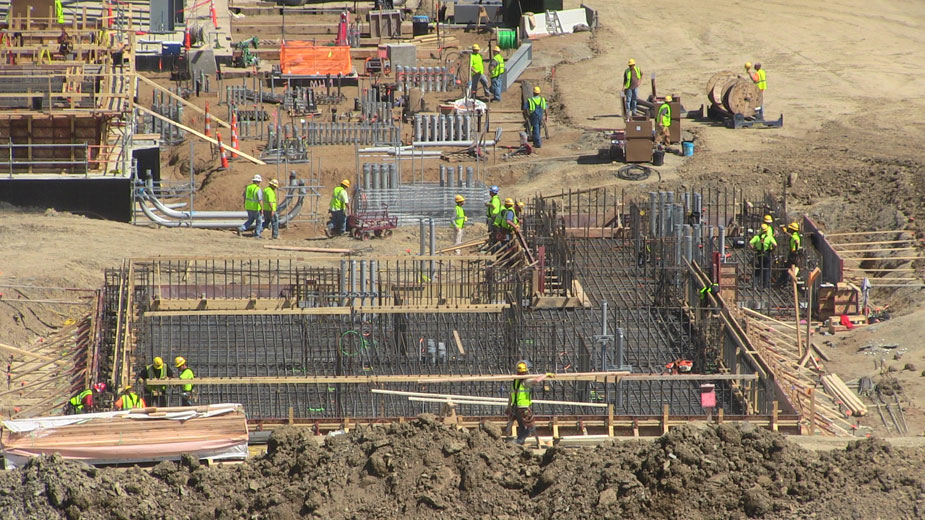$898 Million Energy Plant First of Three for Region
CARROLLTON, Ohio – Were it a year ago, the vantage point where Michael Murphy stands would be a panoramic view of a lush soybean field nestled into the quiet heart of Carroll County.
Today, as Murphy surveys the view from atop a hillside just off state Route 9, that soybean field is long gone. In its place is a giant worksite filled with more than 200 tradesmen clad in fluorescent green vests, scores of earth-moving equipment, mountains of dirt and gravel, and the foundation of what by the fall of 2017 will be an $899 million electricity generation plant.
“At peak, there should be 500 workers at the site” at one time, says Murphy, site manager for Carroll County Energy LLC, a subsidiary of Advanced Power, which is building the new plant. In all, the construction phase of the project should employ about 700 total by the time the plant is commissioned, scheduled for October 2017.
Advanced Power, headquartered in Zug, Switzerland, with offices in Boston and London, announced in April 2015 that it had closed on financing the electricity generation plant, which would be fueled by natural gas and built on 77 acres two miles north of the village of Carrollton. The site proved attractive for several reasons, one of the most important being its proximity to an abundant supply of natural gas via the more than 1,200 producing natural gas wells in Ohio’s Utica shale – more than 400 in Carroll County alone. Another is that the site provides access to major electric transmission lines.
One phase of the project – the electricity transmission station – is finished, Murphy says. “It’s like a very large, complex extension cord,” he says, as he points to the array of aluminum girders, conduit, and wiring that sit atop a hill that overlooks the busy construction site. Power generated from the plant is fed into this station, then transferred to the grid.
Projects of this magnitude and nature usually take between five and six years to complete, from idea to commission, Murphy says. “It starts with a concept,” he says, assessing the potential and probability of success of your idea, and the location to place the plant. Then, the project moves into the development phase.
This step is critical, Murphy says, because many aspects of the project are in motion simultaneously. The process of securing the appropriate permits, negotiating site acquisition, lining up equipment contractors, and opening discussions with major financing sources can take more than two years to complete before any dirt is moved at the site.
“Permitting – especially the air permit – normally takes about two years to get approved,” Murphy says. “They’re sensitive about the amount of emissions you’re putting into the air.” Permits for power plants that use coal as their major fuel source, for example, might take as long as five years to obtain. “Construction cannot start unless these permits are in place because the regulatory agencies can shut the project down,” he says.
Meanwhile, project managers are working to develop contracts for the plant’s major pieces of equipment – in this case, two GE 7F gas turbines and a D602 steam turbine – and the construction of the complex. These turbines have the capability to generate 700 megawatts – enough electricity to power 750,000 homes. “These are the latest revision of GE’s Frame 7,” some of the most sophisticated equipment in the industry, Murphy says.
As a combined cycle plant, it will operate only by cleanly burning natural gas. It will also capture heat the gas turbines emit to create steam, which powers a third turbine, Murphy explains.
“A gas turbine for all intents and purposes is a jet engine,” he says. Hot gas discharged from the gas turbine could reach 2,000 degrees Fahrenheit. “That’s a lot of energy to throw away. In a combined cycle, you take that heat and make steam, which powers another turbine and generates electricity.”
While work was underway to line up equipment suppliers and contractors, partners were working to secure the financing package for such a big project, Murphy notes. “So, there was already a significant investment made before any dirt was turned,” he says.
On a bright, warm afternoon in April, about 200 tradesmen are bust-ling at the worksite. Much of the underground preparation is complete, and now the project is starting to “go vertical,” as Murphy puts it.
At the center of the clearing is a large steel frame that stands about 150 feet in height that will form the plant’s heat recovery unit used for its steam turbine system. Maneuvering above the frame is an enormous crane that towers more than 300 feet into the air and dominates the entire site. It can handle the heavy structural steel needed to build the plant.
“Most of the people working on this project live within an hour and a half of the site,” Murphy says. That means the Carroll County job draws from the local skilled-trades unions, including those from the Mahoning Valley and western Pennsylvania. “Ninety percent of the workers are local,” he remarks. “The major source of labor is through the trades – the local unions.”
Indeed, the Carroll County Energy project is already having a significant impact on work opportunities for skilled tradesmen in the Mahoning Valley. Don Crane, president of the Western Reserve Construction and Building Trades Council, says about one-third of the workforce at the Carroll County project is drawn from craft unions from this region. “It’s right on schedule,” he says. “The weather has helped a lot.”
For example, all of the millwrights on the Carroll County job, Crane emphasizes, are from Local 1871 of the Millwright & Piledrivers union based in Boardman, Crane says.
The project in Carroll County gives Mahoning Valley residents a glimpse of what should transpire over the next year in Lordstown, where Clean Energy Future LLC has begun work on an electrical generation plant of similar size just off state Route 45 in Trumbull County.
“The Lordstown project should be a mirror image,” Crane says. “We’re just underway and we’ve got some crafts working out there now.”
Bechtel is the primary contractor on the Carroll County project. It was recently awarded the work for a second Advanced Power generation plant near Wellsville – South Field Energy – in southern Columbiana County. That project is in its early stages and is expected to cost $1.1 billion.
The South Field plant is the third new power plant underway in northeastern Ohio in less than three years.
Stricter environmental regulations, the need to replace existing inefficient power plants, and the low-cost of natural gas are the driving forces behind the push to retire older coal-burning plants and replace them with more efficient natural gas-fueled plants.
Domestic natural gas production is at record levels, thanks to unconventional oil and gas exploration in rock formations such as the Utica and Marcellus shale in Pennsylvania. In its 2016 energy report, ExxonMobil said natural gas is likely to pull even with coal in generating electricity over the next year.
And according to the Energy Information Administration, natural gas exceeded coal as the leading source of power in the United States for five straight months ended in November 2015.
The enormous quantities of natural gas unleashed by hydraulic fracturing and horizontal drilling have pushed utility companies to invest in many of these new, modern and cleaner-energy plants. More important, just where these new generation complexes are placed stands to affect the regional economy over the years.
An economic impact study completed in 2013 by EDRG Inc. projected that the Carroll County plant would result in $655.2 million in direct economic benefits, including 500 new temporary construction jobs – now revised upward to 700 positions. Another $62.5 million and 156 new jobs would be realized through the purchase of local supplies and services, while an induced economic impact of $127.4 million and 450 new jobs would result from workers spending their wages in local restaurants, stores and hotels.
“The restaurants are very busy here in Carrollton,” Murphy says. Two new hotels have been constructed in the village since the oil and gas industry hit full force about five years ago in this part of Ohio, and one of the larger local car dealerships is expanding – again, he observes.
Meanwhile, the Carrollton Exempted Village School District is already enjoying the benefits of the project. Late last year, the school system received its first $1.3 million installment from Carroll County Energy resulting from an enterprise zone agreement the company signed before work began on the project. Under the agreement, Carroll County Energy pays the school district $1.3 million annually over the next 30 years in lieu of property tax payments to the county. The school district is spending the money on new academic programs and to build a new high school.
Despite the increased truck traffic, the county and village are fully behind the effort to build the plant, Murphy relates.
“I had a salesman here and we went to lunch. And he noticed all of the mud and dirt on the floor of the restaurant,” Murphy recalls, the result of increased foot traffic. “He said to the owner, ‘This must really annoy you.’”
“ ‘No,’ ” Murphy remembers the restaurant owner saying. “ ‘We really like this.’ ”
Copyright 2024 The Business Journal, Youngstown, Ohio.



